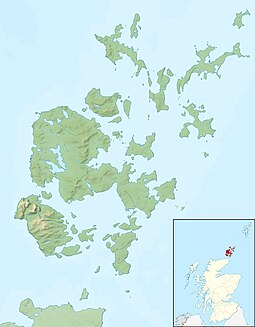Eynhallow is a small, presently uninhabited island in Eynhallow Sound, between Rousay and the Mainland of Orkney, off the north coast of mainland Scotland. It is 75 hectares (0.29 square miles) in area. There is an unnamed skerry about 100 metres (330 feet) to the north-east of the island, separated by Fint Sound. Sheep Skerry adjoins the southern end of the island.
| Old Norse name | Eyinhelga[1] |
|---|---|
| Meaning of name | Holy island |
 Eynhallow viewed from Rousay, from the north-east, with the Orkney Mainland beyond | |
| Location | |
| OS grid reference | HY359291 |
| Coordinates | 59°08′N 3°07′W / 59.14°N 3.11°W |
| Physical geography | |
| Island group | Orkney |
| Area | 75 hectares (0.29 sq mi) |
| Area rank | 168 [2] |
| Highest elevation | 30 metres (98 ft) |
| Administration | |
| Council area | Orkney Islands |
| Country | Scotland |
| Sovereign state | United Kingdom |
| Demographics | |
| Population | 0[3] |
| References | [4][5][6][7] |
There is no ferry to the island, although Orkney Heritage Society organises a trip each July.[8] Otherwise, visitors have to arrange their own transport to the island by private local boat hire. Access can be problematic, as there are strong tidal surges in the surrounding strait, funnelled between Mainland and Rousay.[9]
Etymology
editThe Norse named the island Eyinhelga,[1] meaning "holy island".[6] Johan Blaeu's 17th century Atlas Novus records the name as Alhallow.[10] Skene's 19th century translation of John of Fordun's 14th century Chronica Gentis Scotorum records the name as Enhallow.[11]
History
editThe island's main attraction is Eynhallow Church, dating from the 12th century or earlier, and perhaps originally part of a monastery.[12] The site is maintained by Historic Scotland.
In 1841 the island had a population of 26.[12] It has been uninhabited since the landowner cleared crofters away in 1851. The clearing led to the discovery of the church ruins, forgotten until then.[13] The island is now a bird sanctuary.
Described as "perhaps the most mystical of the Orkney isles",[14] it has its own folklore concerning the initial finding of the island. Eynhallow was believed to be the summer residence of the shape-shifting mer-people the Finfolk before they were driven away by a farmer from Evie, the Guidman o' Thorodale.[15][16]
Cinderella stamps
editCinderella stamp issues have been made for Eynhallow since at least 1973. They have no postal currency.[17]
See also
editNotes
edit- ^ a b Anderson (1873) p. 176
- ^ Area and population ranks: there are c. 300 islands over 20 ha in extent and 93 permanently inhabited islands were listed in the 2011 census.
- ^ National Records of Scotland (15 August 2013). "Appendix 2: Population and households on Scotland's Inhabited Islands" (PDF). Statistical Bulletin: 2011 Census: First Results on Population and Household Estimates for Scotland Release 1C (Part Two) (PDF) (Report). SG/2013/126. Retrieved 14 August 2020.
- ^ Haswell-Smith 2004, pp. 381–383.
- ^ Ordnance Survey: Landranger map sheet 6 Orkney (Mainland) (Map). Ordnance Survey. 2014. ISBN 9780319228128.
- ^ a b Orkney Placenames. Orkneyjar. Retrieved 5 March 2024.
- ^ Pedersen, Roy (January 1992) Orkneyjar ok Katanes (map, Inverness, Nevis Print)
- ^ Orkney Heritage Society website
- ^ "Eynhallow". Around Rousay. Retrieved 8 January 2008.
- ^ Irvine 2006, p. 30.
- ^ John of Fordun 1872, p. 41.
- ^ a b "Overview of Eynhallow". Gazetteer for Scotland. Retrieved 5 January 2008.
- ^ "Eynhallow Church". Historic Environment Scotland. Retrieved 16 January 2022.
- ^ Hewitson 2003, p. 187.
- ^ "Folklore". orkneyjar.com. Retrieved 8 January 2008.
- ^ Turnbull, Catherine (29 July 2010) "Exploring the Mysteries of Eynhallow". Kirkwall: Orkney News.
- ^ "Scotland, Eynhallow: Cinderella Stamps," colnect.com. Retrieved 6 October 2024.
References
edit- Haswell-Smith, Hamish (2004). The Scottish Islands. Edinburgh: Canongate. ISBN 978-1-84195-454-7.
- Anderson, Joseph (ed.) (1873) The Orkneyinga Saga. Translated by Jón A. Hjaltalin & Gilbert Goudie. Edinburgh. Edmonston and Douglas. The Internet Archive. Retrieved 26 August 2013.
- Irvine, James M., ed. (2006). The Orkneys and Schetland in Blaeu's Atlas Novus of 1654. Ashtead: James M. Irvine. ISBN 0-9544571-2-9.
- John of Fordun (1872). Skene, William Forbes (ed.). John of Fordun's Chronicle of the Scottish Nation. Vol. IV. Translated by Skene, Felix James Henry. Edinburgh: Edmonston and Douglas. Retrieved 11 February 2024.
- Hewitson, Jim (2003). "The North Isles". In Omand, Donald (ed.). The Orkney Book. Edinburgh: Birlinn. ISBN 1-84158-254-9.
External links
edit59°8′41″N 3°7′11″W / 59.14472°N 3.11972°W
